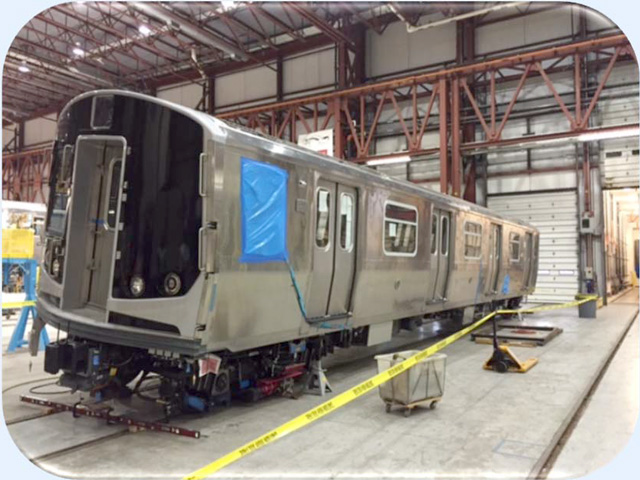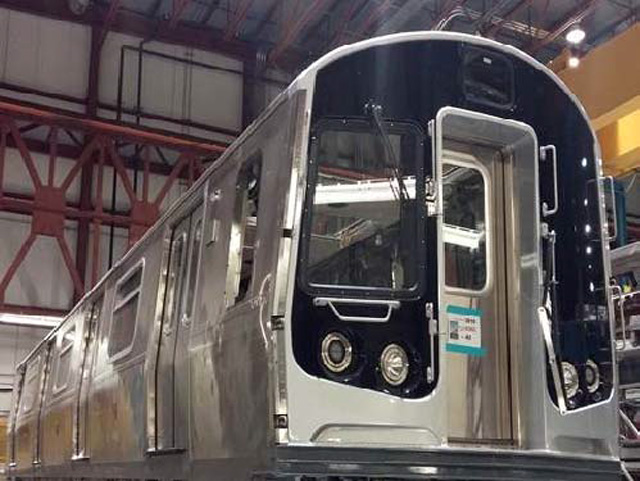-
Posts
338 -
Joined
-
Last visited
-
Days Won
1
Content Type
Profiles
Forums
Gallery
Downloads
Events
Blogs
Posts posted by rbrome
-
-
What about digital advertising, it would be better then the old fashion ads we see currently on the fleet
That's an interesting idea. It would be easy for them to be too bright and therefore very obnoxious. Not to mention that they would obviously display video. Of course anything more attention-getting is something advertisers love, so it's probably inevitable.
One thing that may hold this up is waste heat. LEDs are very efficient, but far from perfectly efficient. An LED screen of any decent size outputs notable heat. Stand next to the LED walls at Fulton Center and you'll see what I mean. That's not a big deal for a small strip sign, etc., but covering the whole area that ads currently cover inside a subway car, it could be a serious issue. Perhaps if they're not too bright (as would be appropriate for that viewing distance) then it's fine, but I'm not sure.
0 -
This Olympics will be captured and broadcast in 8K:
http://arstechnica.com/gadgets/2016/08/worlds-first-8k-tv-broadcasts-begin-for-rio-olympics/
But again, I'm more interested in the fact that full-color modular LED panels with 2mm dot pitch are common, and they even come in 1mm and 0.7mm varieties. You can do a lot with that in a subway car.
0 -
4K and 8K are impractical for anything that isn't jumbotron size because the file sizes would be way too large, and below a certain size the difference is pretty negligible.
In a few years when 100" TVs are within reach for most people, you might feel differently.

Regardless, the point is that full-color LED panels have indeed reached sufficient pixel density for numerous interesting applications in subway car designs. (Obviously not anything close to 4K, but perhaps similar pixel density. That's the point.)
And they're sufficiently rugged, too. I was at an event yesterday where I walked on a huge stage that was one giant hi-res LED screen.
0 -
8K content is now being broadcast in Japan.
An 8K LED screen is certainly possible. The video billboard on the Marriott Marquis in Times Square is pretty close. LED video walls are just modular tiles, so you can combine as many as you like for almost infinite resolution. The newest video walls have a pixel pitch as fine as 0.7mm, which translates to an 8K screen that's about 17 x 10 feet.
0 -
I wonder how the open gangway setup will work. Will it be like the old articulated cars, with shorter car body segments on a non matching number of trucks; or is it really 60 foot cars with the space sealed up? Not sure how they'll be able to have it sealed like that, and the cars not move too much relative to each other..
As is often discussed here, open gangways are extremely common all over the world. It's an old technology. In most systems that I've seen, each car has two trucks, just like old-style cars. In fact I'm pretty sure everything below the floor is exactly the same.
The only modern trains I can think of with shared trucks are light rail and high-speed rail. I'm not sure why, but I don't think it's common with heavy-rail metros these days.
0 -
I would hate this. Train operators can make decisions that computing can not do. They also know what to do in an emergency, how to help confused passengers, and for god's sake they are a living human being. Also, the railfanning hobby will go down, as we won't have people who work on the inside, and actually know what is going on. We won't have people to look up to anymore.
I've ridden a fully automated line. (The new L9/L10 in Barcelona.) It's amazing for railfans. With no cab, you can stand right in front at a giant window. It's glorious.
 1
1 -
New R211 design renderings:
https://www.governor.ny.gov/sites/governor.ny.gov/files/atoms/files/MTA_renderings.pdf
4 -
Releasing a newsletter every month is interesting because it shows just how slowly the work is going at Lex-63rd! Even reading the announcements section makes it sounds like there was little to no progress. Can't wait to see almost the exact same wording in next month's newsletter (Maybe the plaza by the new station entrances will finally open, if we're lucky - MTACC has been "finalizing turnover to the Royale" for months now)
Agreed, and I thought the same from visiting in person. I was there a few months ago, and it looked close to being done. Then I went just a week ago, and was shocked to see relatively little progress. I mean it's mostly finishes work, but there's a lot left to be done, even though it seems like it should be complete by now. They seem to be dragging their feet just because that station is the furthest along, but I worry it will be a tortoise-and-hare situation in a few months, where the other stations catch up and suddenly everyone wonders why 63rd isn't 100% finished.
At least the plaza is open now.
0 -
Big news! R211 bidding is to start by end of this month:
https://twitter.com/MTA/status/755062291058614273
...and include 750 open-gangway cars!
https://twitter.com/MTA/status/755063401945133056


 1
1 -
The MTA may as well just move forward to the R211s adding more 300 cars than currently proposed or what ENY said about the R160s. One or the other doesn't sound bad because it's either train with familiar (160) or newest (211) hardware/software. They may as well have the 300 (or equivalent) phased as the gangway test train order (R211T) unless it becomes a failure, in which I'll cross my fingers during the phase period....
...
Hmm. That would be interesting. So just cancel R179, accelerate R211, and add on an option for 300 R211Ts... I like it.
0 -
Well, that'd be wonderful
 ...but, sadly, doesn't seem quite as realistic. 0
...but, sadly, doesn't seem quite as realistic. 0 -
Oh good. I like the top one better.

Thanks!
0 -
I do prefer the alternative plan to route Phase 4 along a path closer to the eastern edge of Manhattan. The LES just gets totally screwed.
I agree, but I'd start even further north.
Alphabet City has been a complete transit desert for too long. The East Village is pretty well-served by the 6, F and L. But there's a real gap around Tompkins Square and to the south-east.
Why not run the SAS so it crosses 14th at Avenue A, connecting with the 1st Ave station on the L, then a new station around Ave A and 5th/6th (bringing much-needed service to that part of the East Village and Alphabet City), then connect with Delancy on the F instead of Grand on the B/D?
0 -
Do we know the final design for the front? I've seen a reference or two here to a "design change", but searching and going back pretty far, I can't find details on that. (Sorry if I missed it.) I also can't tell if that's related to the two different designs we've seen for the front.
The published MTA progress report seemed to show two different designs for the front in the same document. Does anyone know which is the final design? The bottoms look very different.

 0
0



R211 Discussion Thread
in New York City Subway
Posted
Both good points. Yes, current technology makes it dirt cheap to display extremely high-resolution graphics, short of full video content.
But we're not even talking about high resolutions at all here. We would only be talking about anything close to 4K if you were to put a 4K LCD or OLED panel on the front of the train, but that would be stupid. We're talking about LED panels, which are square modules with far less resolution at the physical sizes we're talking about.
With 1mm dot pitch (approx. the current state of the art for LED panels) 12 inches = approx. 300 pixels. That's sharp enough to display a lot of info and look crisp, but it's absolutely nothing in terms of processing power and storage needs. You can drive a 1920×1080 pixel display with a $20 hobby board (Rasperry Pi, etc.)
OR, for inside the train, they do make high-res LCD panels that are half-height, that would be suitable for replacing FIND, etc. LCDs are not suited to exterior train applications, but may be fine for inside the cars.